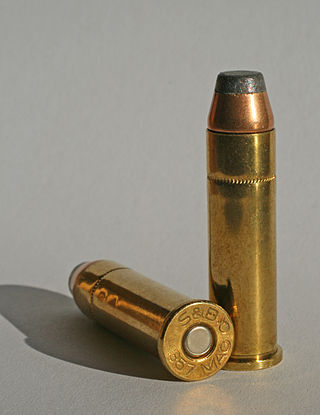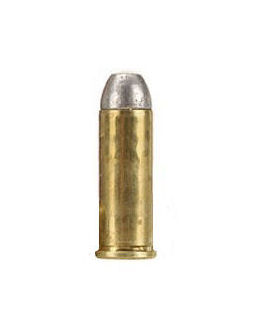Handloading, or reloading, is the practice of making firearm cartridges by assembling the individual components, rather than purchasing mass-assembled, factory-loaded ammunition.

A cartridge or a round is a type of pre-assembled firearm ammunition packaging a projectile, a propellant substance and an ignition device (primer) within a metallic, paper, or plastic case that is precisely made to fit within the barrel chamber of a breechloading gun, for the practical purpose of convenient transportation and handling during shooting. Although in popular usage the term "bullet" is often informally used to refer to a complete cartridge, the correct usage only refers to the projectile.

The .38 Special, also commonly known as .38 S&W Special, .38 Smith & Wesson Special, .38 Spl, .38 Spc,, or 9x29mmR is a rimmed, centerfire cartridge designed by Smith & Wesson.

A centerfire cartridge is a firearm metallic cartridge whose primer is located at the center of the base of its casing. Unlike rimfire cartridges, the centerfire primer is typically a separate component seated into a recessed cavity in the case head and is replaceable by reloading.

The .357 Smith & Wesson Magnum, .357 S&W Magnum, .357 Magnum, or 9×33mmR, is a smokeless powder cartridge with a 0.357 in (9.07 mm) bullet diameter. It was created by Elmer Keith, Phillip B. Sharpe, and Douglas B. Wesson of firearm manufacturers Smith & Wesson and Winchester. The .357 Magnum cartridge is notable for its highly effective terminal ballistics.

Rimfire ammunition is a type of firearm metallic cartridge whose primer is located within a hollow circumferential rim protruding from the base of its casing. When fired, the gun's firing pin will strike and crush the rim against the edge of the barrel breech, sparking the primer compound within the rim, and in turn ignite the propellant within the case. Invented in 1845, by Louis-Nicolas Flobert, the first rimfire metallic cartridge was the .22 BB Cap cartridge, which consisted of a percussion cap with a bullet attached to the top. While many other different cartridge priming methods have been tried since the mid-19th century onwards, such as pinfire, only small caliber rimfire and centerfire cartridges have survived to the present day with regular usage. The .22 Long Rifle rimfire cartridge, introduced in 1887, is by far the most common ammunition in the world today in terms of units sold.

The .22 Long Rifle or simply .22 LR or 22 is a long-established variety of .22 caliber rimfire ammunition originating from the United States. It is used in a wide range of rifles, pistols, revolvers, smoothbore shotguns, and submachine guns.

The .45 Colt (11.43×33mmR), is a rimmed, straight-walled, handgun cartridge dating to 1872. It was originally a black-powder revolver round developed for the Colt Single Action Army revolver. This cartridge was adopted by the U.S. Army in 1873 and served as an official US military handgun cartridge for 14 years, before being replaced by the .38 Long Colt in 1892.

The .38 Long Colt, also known as .38 LC, is a black powder cartridge introduced by Colt's Manufacturing Company in 1875. In 1892, it was adopted as a standard military pistol cartridge by the United States Army for the Colt M1892 revolver. The metric designation for the .38 Long Colt is 9.1×26mm. It is slightly more powerful than the .38 Short Colt, also known as .38 SC. The original .38 SC and .38 LC differ in case length, bullet diameter, weight, and design and are not interchangeable; however, modern production .38 SC ammunition is now loaded with a smaller, internally-lubricated bullet which can be fired from firearms chambered in .38 LC or .38 Special. The modern .38 LC can be fired from .38 Special firearm, but not from a firearm designed for the .38 SC, since the case length is too long.

The .44 Remington Magnum, also known as .44 Magnum or 10.9x33mmR, is a rimmed, large-bore cartridge originally designed for revolvers and quickly adopted for carbines and rifles. Despite the ".44" designation, guns chambered for the .44 Magnum round, its parent case, the .44 Special, and its parent case, the .44 Russian all use 0.429 in (10.9 mm) diameter bullets. The .44 Magnum is based on the .44 Special case but lengthened and loaded to higher pressures for greater velocity and energy.

The .44 Smith & Wesson Special, also commonly known as .44 S&W Special, .44 Special, .44 Spl, .44 Spc, or 10.9×29mmR, is a smokeless powder center fire metallic revolver cartridge developed by Smith & Wesson in 1907 as the standard chambering for their New Century revolver, introduced in 1908.

The .32-20 Winchester, also known as .32 WCF , was the first small-game lever-action cartridge that Winchester produced. It was initially introduced as a black-powder cartridge in 1882 for small-game, varmint hunting, and deer. Colt produced a single-action revolver chambered for this cartridge a few years later.

The .44-40 Winchester, also known as .44 Winchester, .44 WCF, and .44 Largo was introduced in 1873 by the Winchester Repeating Arms Company. It was the first metallic centerfire cartridge manufactured by Winchester, and was promoted as the standard chambering for the new Winchester Model 1873 rifle. As both a rifle and a handgun caliber, the cartridge soon became widely popular, so much so that the Winchester Model 1873 rifle became known as "The gun that won the West."

A heeled bullet is a bullet that is necked-down at its base to allow a projectile the full internal diameter of a gun barrel to fit in a cartridge case of the same or narrower dimension. Heeled bullets mostly disappeared with the advent of smokeless powder cartridges, though older rimfire designs, such as the .22 caliber rimfire cartridges, still use heeled bullets, and many cartridges that date back to the black powder era still reflect their heeled bullet origins in their caliber designations.

The .41 Long Colt cartridge was created in 1877 for Colt's double-action "Thunderer" revolver.

Overpressure ammunition, commonly designated as +P or +P+, is small arms ammunition that has been loaded to produce a higher internal pressure when fired than is standard for ammunition of its caliber, but less than the pressures generated by a proof round. This is done typically to produce rounds with a higher muzzle velocity and stopping power, such as ammunition used for security, defensive or hunting purposes. Because of this, +P ammunition is typically found in handgun calibers which might be used for armed security and defensive purposes.

The .44 Russian, also known as the .44 S&W Russian, is a black-powder center-fire metallic revolver cartridge developed and produced by Smith & Wesson in 1870. The .44 Russian design marked the first use of an internally lubricated bullet in modern firearm ammunition.

The .44 S&W American is an American centerfire revolver cartridge.

The term .32 rimfire refers to a family of cartridges which were chambered in revolvers and rifles in the late 19th and early 20th centuries. These rounds were made primarily in short and long lengths, but extra short, long rifle and extra long lengths were offered.

The .44 Remington Centerfire was a centerfire revolver cartridge with a heeled, externally lubricated bullet produced by the Remington Arms Company from 1875 until 1895. Only one weapon, the Remington Model 1875, was chambered for this cartridge.




















